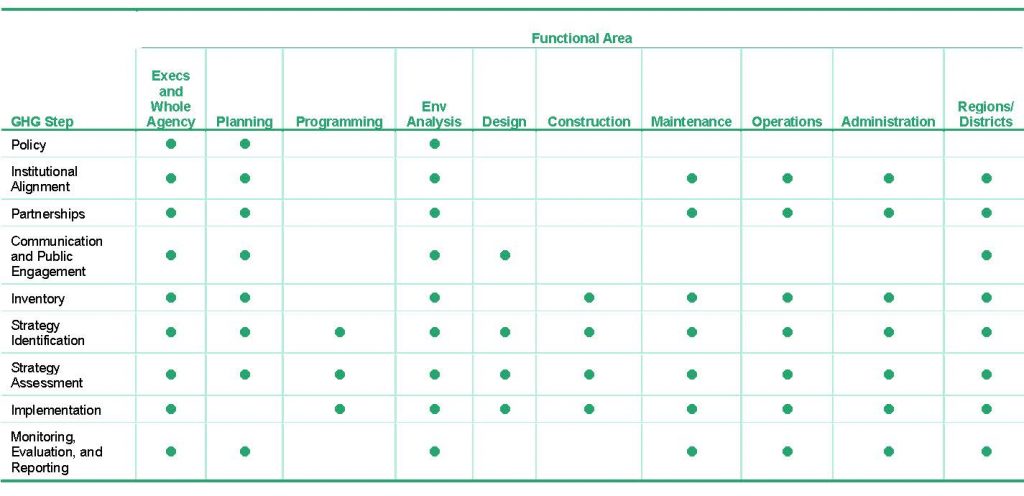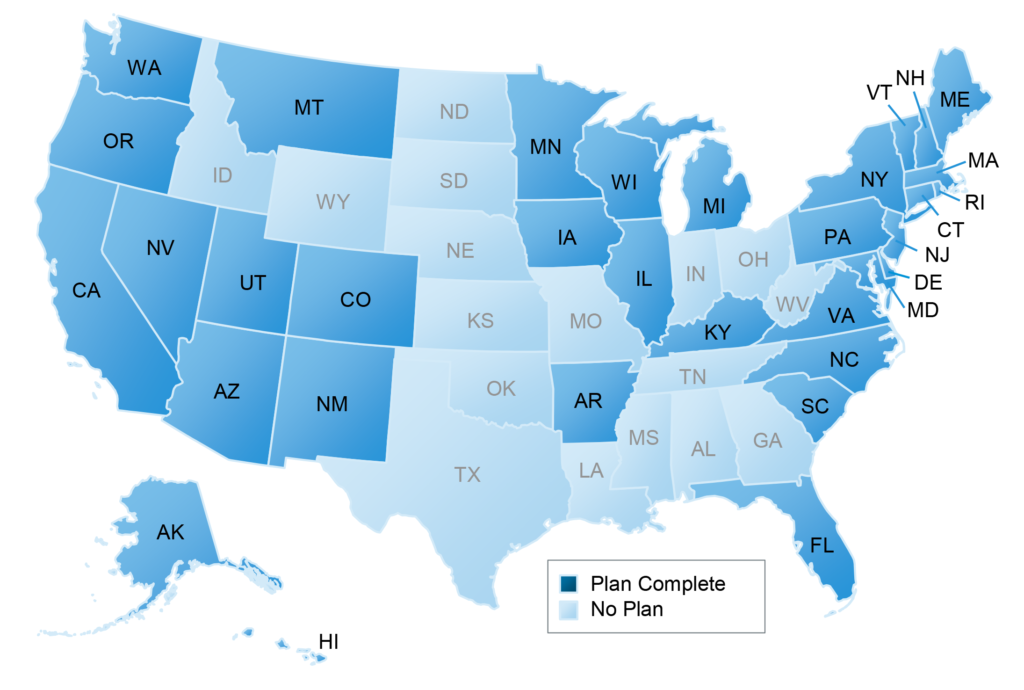4.0 Greenhouse Gas Action Across the Agency
- 4.1 The GHG Action Spectrum
- 4.2 Levels of Engagement
- 4.3 GHG Interests of Each Functional Area
- 4.4 Synergies with Other Program Objectives
- 4.5 Responding to State or Federal Requirements
4.1 The GHG Action Spectrum
A transportation agency can address greenhouse gas (GHG) emissions through a multistep process that begins with developing an inventory to understand what the agency and the users of the transportation system are emitting and continues with developing and implementing mitigation strategies, monitoring results, and making adjustments. Clear and consistent policies, institutional alignment, and partnerships with other divisions and agencies set the stage for effectively addressing GHG across the agency.
This process can be applied across all of an agency’s functional areas.[1] Table 4.1 illustrates the various steps in addressing GHG emissions across a transportation agency’s spectrum of activities. This framework is used as the main organizing framework for this guide, so that anyone can refer to the section on their own functional area and review the actions they can take to understand and reduce GHG emissions. These steps as tied to the “Plan, Do, Check, Act” cycle familiar to most departments of transportation (DOTs) (see Section 19.0, Putting It All Together) include
- Policy development—High-level decision-making on the types of consideration and actions that should be taken to address GHG emissions.
- Institutional alignment—Coordinating activities across the various divisions of the DOT.
- Partnerships—Working with external partners, including other State, regional, and local agencies, to coordinate on GHG reduction goals and activities.
- Inventory (and forecast) development—Defining which emissions sources are to be included; describing the current-year quantity of GHG emissions from each source considered within the scope; and, as applicable, projecting baseline future year emissions if no actions are taken to affect these emissions (beyond current policies).
- Goal- and target-setting—Establishing specific metrics, goals, and targets for reducing future GHG emissions.[2]
- Strategy identification—Considering additional GHG reduction strategies that could be implemented.
- Strategy evaluation—Evaluating GHG reduction strategies, their effectiveness, and how they could change overall emissions in the future.
- Implementation—Action steps to implement selected strategies to reduce GHG emissions.
- Monitoring, evaluation, and reporting—Continuing to estimate GHG emissions over time and comparing these against baseline projections and/or targets (if adopted) to measure progress. Data standardization across the agency will assist with accurate reporting as well as other steps in this process, from inventory development to strategy evaluation.
- Communications and public engagement—Communicating with stakeholders and the public regarding GHG emission reduction activities, both to inform and to obtain feedback.
Table 4.1 The GHG Action Spectrum

4.2 Levels of Engagement
This guide applies a “levels of engagement” model to help State DOTs assess where they are with respect to GHG engagement and where they want to go. Four levels are established in keeping with a nationwide survey with reference to policy, practice—internal (agency-generated emissions), practice—system (transportation system emissions), and technology (data and tools). These are shown in Table 4.2. Depending on circumstance, different functional areas may be at different levels of engagement within the same agency.
Table 4.2 GHG Levels of Engagement
| Engagement Level |
Policy | Practice: Internal | Practice: System | Technology |
| Level 1 | New to the topic; few or no formal actions to address GHG. | |||
| Level 2 | Has established general policies, goals, and/or objectives related to GHG. | Agency emissions considered. | No formal consideration of transportation system emission reduction. | No or limited/partial GHG inventory. |
| Level 3 | Has established specific policies, goals, and/or objectives related to GHG. | Applies quantitative project or program evaluation criteria to agency emissions. | Qualitative project or program evaluation criteria. | Has developed GHG inventory and/or forecast. |
| Level 4 | Coordinated multiagency effort. | Strategic planning: has evaluated GHG reduction strategies, linked strategies to plans and programs, and conducted quantitative assessment. | Strategic planning: has evaluated GHG reduction strategies, linked strategies to plans and programs, and conducted quantitative assessment. | Has developed inventory, forecast, and specific data and measurement methods and established a range of specific policies, goals, and/or objectives related to targeted GHG reductions. |
4.3 GHG Interests of Each Functional Area
As illustrated, virtually all functional areas can contribute in some way to GHG efforts, at least at higher levels of engagement. Organizational functions vary from agency to agency, but, in general, DOT organizational units tend to exhibit interests and functions related to GHG reduction as shown in Table 4.3. (Additional details on unit functions as they relate to GHG interests may be found in Section 6.0, Institutional Considerations and Alignment, and in the sections specific to each functional area.)
Table 4.3 DOT Functional Areas: Typical GHG Interests and Responsibilities
| Functional Area | GHG Interests and Responsibilities |
| Executive |
|
| Administration |
|
| Planning |
|
| Programming |
|
| Environment |
|
| Project Development and Design |
|
| Construction |
|
| Maintenance |
|
| Operations |
|
| Regions/Districts |
|
4.4 Synergies with Other Program Objectives
Addressing GHG does not require an entirely new set of procedures, tools, and methods. Typically, use of existing organizational functions is the most effective approach—especially when synergies with existing policies and initiatives may be realized. For example:
- Sustainability—If an agency already has a sustainability initiative, reducing GHGs would logically be folded under this initiative, and many of the actions to improve sustainability (e.g., reducing energy consumption) would also reduce GHGs.
- Air quality—GHG emission factors can be developed using the same data and models as for criteria air pollutants, so computing GHG emissions requires a very small additional effort when criteria pollutants already are being calculated.
- Mobility—Transportation agencies often set goals to reduce vehicle miles traveled (VMT) or congestion, which also relates directly to GHG reduction.
- Life-cycle cost savings—Construction and maintenance practices to minimize life-cycle costs may include materials and techniques to reduce energy consumption and embedded carbon, thereby reducing GHG emissions.
GHG-specific analysis or actions may still be needed, even when existing institutional structures and processes can be leveraged. For example, some air quality improvement strategies (such as some diesel emission reduction technologies) may have no effect on fuel consumption and GHGs or may even increase them slightly. Some strategies to improve mobility, such as highway widening, could increase GHGs over the long run as a result of induced travel. In the end, “What gets measured is what gets done.”
4.5 Responding to State or Federal Requirements
While some transportation agencies have taken unilateral action to address GHG emissions, often the agency is asked to comply with State (and/or Federal) requirements related to GHG, energy, or sustainability.[3] These may include
- Requirements to develop a sustainability policy or plan. Because of the potential impacts of climate change described in Section 2.0, GHG emissions are a critical element of sustainability, and a comprehensive sustainability plan should include measures to reduce GHG emissions.
- A State climate action or clean energy plan. Many States have already developed such a plan (Figure 4.1), and it typically includes transportation sector action as well as other actions. The State transportation agency can play a stronger role in helping shape this plan if it starts from a position of knowledge about the contribution of the State’s transportation sector to GHG emissions (inventory) and potential reduction opportunities (strategy evaluation).
- State and/or metropolitan transportation GHG reduction targets. Many States have set long-term (typically 2030 or 2050), economy-wide GHG reduction targets, and California and Oregon have set metropolitan area transportation targets.[4] Analysis by the State transportation agency can help to determine feasible targets and understand what actions might be needed to achieve established targets.
- Procedural requirements to consider GHG emissions in long-range planning, programming, and/or project development. At a minimum, the State transportation agency will likely need to develop qualitative criteria for GHG consideration. The agency might also need to, develop quantitative data, including a baseline and alternatives forecast, as well as track progress on emission reductions, including progress towards meeting any established goals, or targets.
- Technology standards or requirements. Some agencies are committed to “best practices” for design and operations. In many cases state of the art design and operation can improve traffic flow and reduce emissions.
Figure 4.1 States with Climate Action Plans as of 2017

[1] State departments of transportation are organized in different ways, with different names for their divisions or units. This guide uses the term “functional area” instead of “division,” “office,” or another term to emphasize the focus on what a particular unit or division does, rather than what it is called. In some cases, one division or office may be responsible for more than one functional area (e.g., an Office of Planning conducting programming as well as long-range planning functions). There may also be some overlap in functional responsibilities across units; for example, the Planning unit may be involved in the earlier stages of project development, with responsibilities transitioning to the Design unit as the project progresses.
[2] The terms “goal” and “target” are sometimes used interchangeably. In this guide, “goal” is defined as a broad, socially driven aim that guides overall decision-making and describes a desired end state; “target” is defined as a quantifiable level of performance or condition, expressed as a value for the measure, to be achieved within a given time period.
[3] While there were no Federal requirements related to GHG emissions in place at the time of this writing, Federal requirements or guidance had been proposed in recent years, including a proposed GHG performance measure under the Moving Ahead for Progress in the 21st Century Act (MAP‑21) and proposed changes to Council on Environmental Quality (CEQ) guidance to consider climate change in National Environmental Policy Act (NEPA) documents.
[4] Oregon’s targets are a per capita, light-vehicle, GHG reduction in Portland of 25 percent, and 20 percent in other metropolitan areas, beyond expected vehicle and fuel improvements by 2040. See ORS 468A.205—Greenhouse Gas Emissions Reduction Goals, as summarized in https://www.oregon.gov/lcd/CL/Pages/Land-Use.aspx.